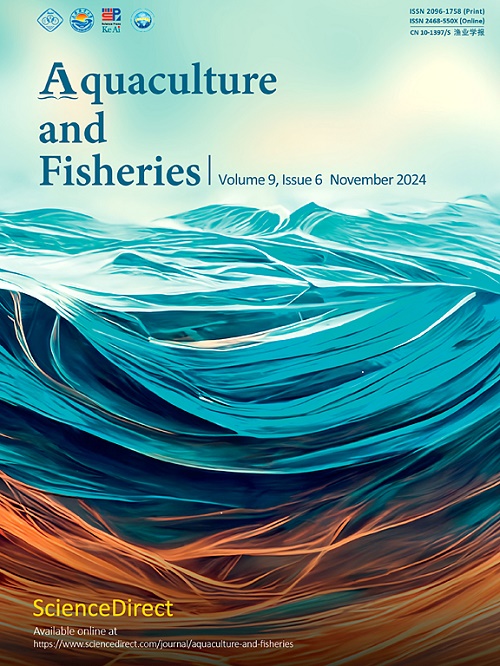Evaluation of growth performances of crossbreds and backcrossbreds with purebreds Nishikigoi and Hungarian carp (Cyprinus carpio)
Q1 Agricultural and Biological Sciences
引用次数: 0
Abstract
This study aimed to evaluate growth curves among different common carp genotypes, according to fingerling performance and morphometry. Fingerlings selected according to Nishikigoi pattern, either (9.66 ± 1.47) cm in standard length, from crossbred and pure carp, respectively, were cultivated in 8 cages (4 replicates for each genotype), measuring 9 m³ (3.0 m × 2.0 m × 1.5 m) each, in a 1500 m2 (12 m × 125 m) pond at a depth of 1.60 m with 10 fingerlings/m³. Fish were fed four times a day at the rate of 5%–7% of biomass with the same specific diet for each growth stage. Forty carp of each genotype (10 fish/cage) were weighed at days 0, 60, 150, 270 and 330 of cultivation. They were weighed and measured for head length, standard length, body height and body width. The Gompertz model was fit for weight × age data for comparison of absolute and relative growth rate, weight and age at the inflection points. The crossbred genotype showed better survival, weight gain and feed conversion compared to pure carp (P < 0.05). The final weight estimate at 330 days was 38.45% higher in the crossbred genotype (289.16 g) when compared to the pure carp (208.85 g). The pure genotype presented lower weight (431.60 g), age (559.71 days) and absolute growth rate (1.03 g/day) at the inflection points when compared to the crossbred genotype (587.69 g; 559.71 days and 1.46 g/day, respectively). Body morphometric relationships changed with fish growth, and this occurred differently, depending on carp genotype evaluated. From these results, it can be concluded that crossing Nishikigoi with Hungarian carp can be a strategy to improve desirable characteristics in koi.
杂交种和回交种与纯种西乡鲤和匈牙利鲤鱼(Cyprinus carpio)生长性能的评估
本研究的目的是根据鱼种性能和形态测定来评价不同基因型鲤鱼的生长曲线。按Nishikigoi模式选择标准长度为(9.66±1.47)cm的杂交鲤和纯鲤鱼种,分别饲养于8个网箱中(每个基因型4个重复),网箱尺寸为9 m³(3.0 m × 2.0 m × 1.5 m),池深为1.60 m,池深为1500 m2 (12 m × 125 m),每m³10条鱼种。每个生长阶段采用相同的特定饲料,每天投喂4次,投喂量为生物量的5% ~ 7%。分别于养殖第0、60、150、270和330天称重,每种基因型各40条,每笼10条。他们称重并测量了头长、标准长度、身体高度和身体宽度。采用Gompertz模型对体重×年龄数据进行拟合,比较绝对增长率和相对增长率,以及拐点处的体重和年龄。与纯种鲤鱼相比,杂交基因型的成活率、增重和饲料系数更高(P <;0.05)。杂交基因型在330天的最终体重估计(289.16 g)比纯鲤鱼(208.85 g)高38.45%。纯基因型在拐点处的体重(431.60 g)、日龄(559.71 d)和绝对生长率(1.03 g/d)均低于杂交基因型(587.69 g;559.71 d和1.46 g/d)。鱼体形态计量学的关系随着鱼的生长而变化,而且这种变化的方式因所评估的基因型不同而不同。从这些结果可以得出结论,西锦井与匈牙利鲤鱼杂交可以改善锦鲤的理想特性。
本文章由计算机程序翻译,如有差异,请以英文原文为准。
求助全文
约1分钟内获得全文
求助全文
来源期刊

Aquaculture and Fisheries
Agricultural and Biological Sciences-Aquatic Science
CiteScore
7.50
自引率
0.00%
发文量
54
审稿时长
48 days
期刊介绍:
 求助内容:
求助内容: 应助结果提醒方式:
应助结果提醒方式:


